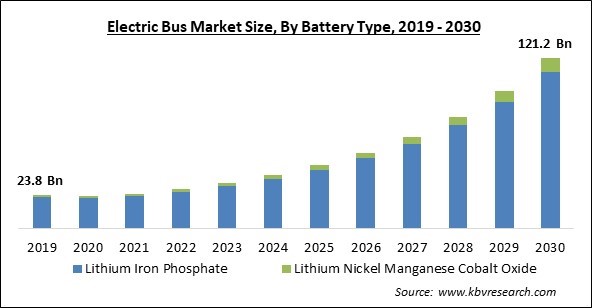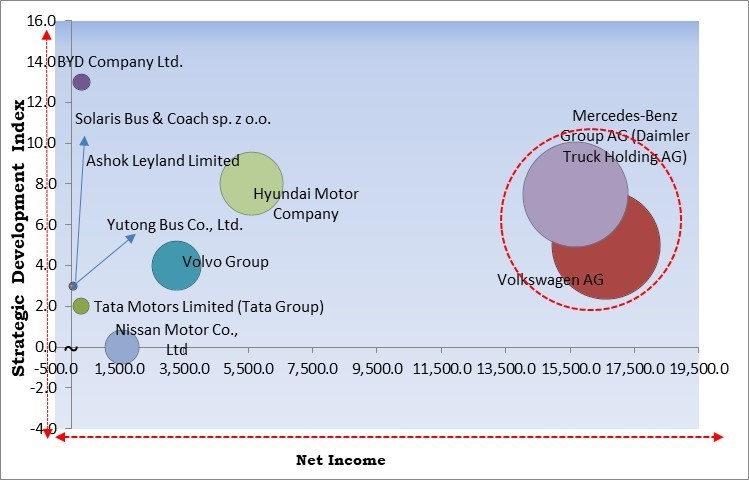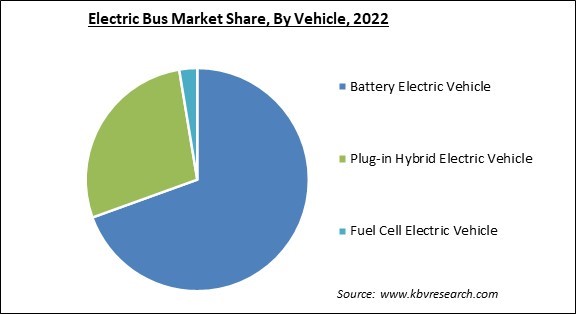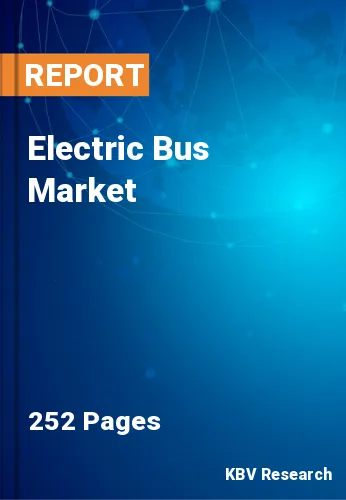The Global Electric Bus Market size is expected to reach $121.2 billion by 2030, rising at a market growth of 20.8% CAGR during the forecast period.
Battery Electric Vehicle are gaining traction in the Market due to the rising greenhouse gas (GHG) emissions. Therefore, Battery Electric Vehicle accounted for $19.3 billion revenue in the market in 2022. Employing hydrogen energy for transportation as well as business and industrial uses will drastically cut GHG emissions. The announcement of GHG emission reduction targets has compelled bus makers to use electric alternatives. For example, 2019 saw the establishment of the Colorado emissions reduction target in the US. By setting the baseline at its 2005 levels, it has set reduction goals of 26% by 2025, 50% by 2030, and 90% by 2050. Similarly, by 2030, Germany wants to reduce carbon emissions by at least 65% compared to 1990 levels. One of the leading nations in adopting electric buses is the Netherlands, which already employs electric public buses in day-to-day operations and wants to have all of its public bus transportation emission-free by 2030. The market is anticipated to increase as a result.

The major strategies followed by the market participants are Product Launches as the key developmental strategy in order to keep pace with the changing demands of end users. For instance, In June, 2023, Yutong Bus Co., Ltd. announced the launch of YEA, a technology platform for energy commercial vehicles. The YEA features two core components namely, the C-architecture used as a CPU of the commercial vehicle and the YOS, a commercial vehicle operating system featuring a self-developed OS by Yutong Bus. Additionally, In April,2023, Daimler Truck AG unveiled the Rizon brand of medium-duty trucks. The Rizon branded trucks feature lithium iron phosphate batteries and a single charge mileage of up to 110 miles.
Based on the Analysis presented in the KBV Cardinal matrix; Volkswagen AG and Mercedes-Benz Group AG (Daimler Truck Holding AG) are the forerunners in the Market. In June, 2023, Volkswagen AG released ID. Buzz electric bus. The ID. Buzz features an electric motor capable of producing power of up to 282 horsepower and a maximum speed of up to 99 mph. Furthermore, the bus features power-sliding doors on both sides. Companies such as Hyundai Motor Company, Volvo Group, Nissan Motor Co., Ltd are some of the key innovators in the Market.

Compared to a comparable gasoline or diesel vehicle, an electric car offers substantially reduced operating costs. Instead of using fossil fuels like gasoline or diesel, electric vehicles charge their batteries using energy. Due to their superior efficiency and lower cost of energy, electric automobiles are more affordable to charge than gasoline or diesel vehicles. Deploying electric vehicles can help protect the environment when powered by renewable energy. If charging is done using renewable energy sources like solar panels placed in bus depots, the cost of electricity can be further decreased. Due to this, nations are moving from conventional to electric vehicles worldwide, causing the market to grow.
Rapid urbanization, fast population growth, the expansion of the industrial sector, and infrastructural development are the primary drivers of the significant increase in good transport vehicles worldwide. Numerous job opportunities are emerging in several industries, like mining, building, and tourism, due to the expansion of the industrial sector, especially in developing countries. As a result, since there are more employment opportunities, there are also more commuters, which has an important impact on the demand for public transportation services. This factor is driving the demand for efficient public transport modes.
The battery needs a management system that guarantees the best operational temperature and security. However, manufacturers must spend a lot of time and money on advanced battery management systems inventions. Regarding electric buses, the size of the battery pack affects both the vehicle's driving range and the battery price. Further complicating the design of the body and chassis of electric buses is the large battery size. Depending on several factors, including the annual/daily mileage, operating temperature, and charging level/rate, these batteries must be replaced at least once or twice throughout the bus's operational lifespan. As a result, such factors are proving to be a significant barrier to market expansion.
On the basis of battery type, the market is classified into lithium nickel manganese cobalt oxide and lithium iron phosphate. The lithium nickel manganese cobalt oxide segment recorded a significant revenue share in the market in 2022. The minerals in this type of rechargeable lithium-ion batteries are used in powder form in batch numbers as a cathode material. Extremely great thermal stability characterizes this material. The nickel magnesium cobalt battery has become more popular for use in electric buses because of its beneficial characteristics, which include a high capacity, cycle rate, and power, in addition to a low self-heating rate.
Based on Vehicle, the market is characterized into battery electric vehicle, plug-in hybrid electric vehicle, and fuel cell electric vehicle. The fuel cell electric vehicle (FCEV) segment procured a considerable growth rate in the market in 2022. Greenhouse gas emissions and air pollution are reduced in part owing to the FCEV. The segment is expanding due to more aggressive government attempts to cut carbon emissions and save the environment. For instance, the use of fuel-cell transit buses is accelerating in Germany. For the production and installation of electric public transportation vehicles in the nation, the German government has made significant contributions.

By application, the market is divided into intercity and intracity. The intracity segment garnered a remarkable growth rate in the market in 2022. The segment is expanding as developing economies become more aware of the need to decrease carbon emissions and as severe emission regulations encourage the usage of electric buses. Clean mobility solutions are now essential due to rising urbanization. Urban population growth would necessitate widespread urban transit, which offers tremendous possibilities for electric mobility.
Based on end-use, the market is segmented into public and private. The public segment procured the highest revenue share in the market in 2022. A significant proportion of the market is linked to the rising demand for transportation services as well as government initiatives to minimize greenhouse gas emissions and reliance on fossil fuels. Public initiatives often focus on developing the necessary charging infrastructure to support electric buses. This includes the installation of charging stations at bus depots, terminals, and along bus routes.
| Report Attribute | Details |
|---|---|
| Market size value in 2022 | USD 27.8 Billion |
| Market size forecast in 2030 | USD 121.2 Billion |
| Base Year | 2022 |
| Historical Period | 2019 to 2021 |
| Forecast Period | 2023 to 2030 |
| Revenue Growth Rate | CAGR of 20.8% from 2023 to 2030 |
| Number of Pages | 252 |
| Number of Table | 413 |
| Report coverage | Market Trends, Revenue Estimation and Forecast, Segmentation Analysis, Regional and Country Breakdown, Competitive Landscape, Companies Strategic Developments, Company Profiling |
| Segments covered | Battery Type, Vehicle, Application, End-use, Region |
| Country scope | US, Canada, Mexico, Germany, UK, France, Russia, Spain, Italy, China, Japan, India, South Korea, Singapore, Malaysia, Brazil, Argentina, UAE, Saudi Arabia, South Africa, Nigeria |
| Growth Drivers |
|
| Restraints |
|
Region wise, the market is analyzed across North America, Europe, Asia Pacific, and LAMEA. The Asia Pacific segment recorded the largest revenue share in the market in 2022. The rise in demand for environmentally friendly transportation and the presence of nations like India, China, and Japan are responsible for the expansion. China is a significant player in the market and the location of top manufacturers. For instance, there were over 466,000 New Energy buses (NEBs) in China by the end of 2020, of which 378,700 were battery electric buses. Strict government regulations, environmental concerns, and expanding charging infrastructure are also boosting the region's demand.
Free Valuable Insights: Global Electric Bus Market size to reach USD 121.2 Billion by 2030
The market research report covers the analysis of key stake holders of the market. Key companies profiled in the report include BYD Company Ltd., Volvo Group, Solaris Bus & Coach sp. z o.o. (Construcciones y Auxiliar de Ferrocarriles, S.A.), Volkswagen AG, Nissan Motor Co., Ltd, Ashok Leyland Limited (Hinduja Group Ltd.), Mercedes-Benz Group AG (Daimler Truck Holding AG), Yutong Bus Co., Ltd., Tata Motors Limited (Tata Group) and Hyundai Motor Company.
By Battery Type
By Vehicle
By Application
By End-Use
By Geography
The Market size is projected to reach USD 121.2 billion by 2030.
Escalating prices for diesel and petrol are driving the Market in coming years, however, High development costs and safety issues with EV batteries restraints the growth of the Market.
BYD Company Ltd., Volvo Group, Solaris Bus & Coach sp. z o.o. (Construcciones y Auxiliar de Ferrocarriles, S.A.), Volkswagen AG, Nissan Motor Co., Ltd, Ashok Leyland Limited (Hinduja Group Ltd.), Mercedes-Benz Group AG (Daimler Truck Holding AG), Yutong Bus Co., Ltd., Tata Motors Limited (Tata Group) and Hyundai Motor Company.
The Intercity segment is generating the highest revenue share in the Global Electric Bus Market by Application in 2022 thereby, achieving a market value of $106.4 billion by 2030.
The Lithium Iron Phosphate segment is leading the Global Electric Bus Market by Battery Type in 2022 thereby, achieving a market value of $111.5 billion by 2030.
The Asia Pacific market dominated the Global Electric Bus Market by Region in 2022, and would continue to be a dominant market till 2030; thereby, achieving a market value of $75.9 billion by 2030.
Our team of dedicated experts can provide you with attractive expansion opportunities for your business.

